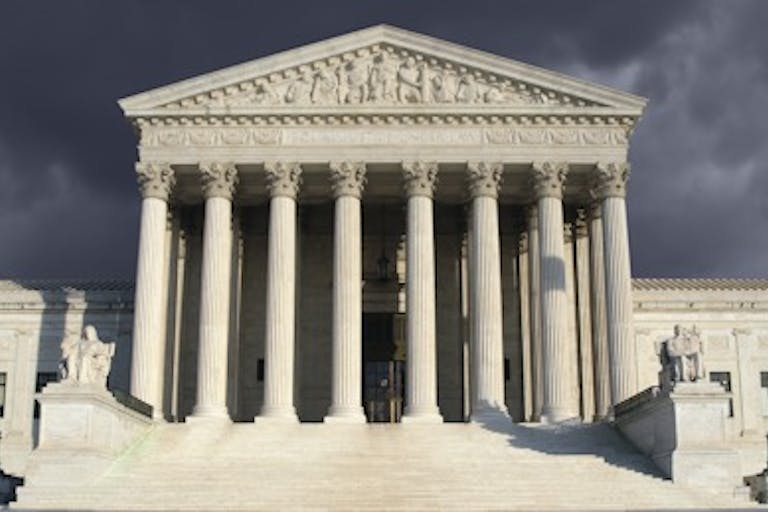
Man convicted of trafficking stolen body parts sentenced to six years in prison
Cassy Cooke
·
Myths about Roe v. Wade
As both an active member of the pro-life movement and a law student, I am frequently confronted with the fact that the vast majority of activists on both sides of the abortion debate have many misconceptions about what Roe v. Wade actually says about the legality of abortion. Most of this arises from the fact that they have not read the case themselves, or if they did read it, they were unable to understand it due to a lack of legal training. My goal is to attempt to clear up four of the most common myths surrounding Roe v. Wade, and the legal state of abortion in general, so that our conversations about the issue will be more informed going forward.
Myth #1: Abortion is a “Fundamental Right”
Many abortion supporters, including elected officials and leaders of pro-abortion organizations, will tell you that the Supreme Court declared abortion a fundamental right in Roe v. Wade, but this simply is not true. In fact, no majority opinion by the Supreme Court has ever declared abortion a fundamental right.
In Constitutional Law, there are three levels of “judicial scrutiny” the Court will use when deciding cases, these levels are: (1) Strict Scrutiny, (2) Intermediate Scrutiny, and (3) Rational Basis Scrutiny. When a fundamental right is at issue in a case, the Court must use the highest level of scrutiny, Strict Scrutiny. Under Strict Scrutiny, the Court presumes the policy to be invalid unless the government can demonstrate a compelling interest to justify the policy being challenged.
While much of the language used in Roe seemed to imply Strict Scrutiny, the Court did not actually declare the right fundamental, and subsequent cases prove this. Indeed, many of the abortion cases that the Court heard between Roe and Planned Parenthood v. Casey dealt with overturning this presumption by the lower courts, though often with contradictory results.
For example, the Court struck down all abortion regulations in Planned Parenthood v. Danforth (1976), City of Akron v. Akron Center for Reproductive Health, Inc. (1983), and Thornburg v. American College of Obstetricians and Gynecologists (1986), but upheld similar and further regulations in Harris v. McRae (1980), Rust v. Sullivan (1991), Connecticut v. Menillo (1975), and Bellotti v. Baird (1976).[1]
In these sometimes contradictory rulings, the Court seemed unsure of how to apply its own rule from Roe. For example, while Thornburg called abortion a “fundamental right,” the Court did not apply Strict Scrutiny.[2] Likewise in Bellotti and Harris, the Court referred only to an “undue burden” or “unduly burdensome” analysis, again ignoring the usual standard of review for “fundamental rights”.[3]
Finally, in 1992’s Planned Parenthood v. Casey, the Court clearly ruled that abortion is not a fundamental right by adopting an Intermediate Scrutiny approach known as “Undue Burden.” Instead of the government having to prove a “compelling interest”, the burden of proof was now placed on those challenging the law, who must prove that the law places an “Undue Burden” on a woman seeking an abortion. Since then, the “Undue Burden” standard has been used in every case dealing with abortion to be heard before the US Supreme Court, clearly showing that abortion is not a fundamental right.
Myth #2: Roe legalized abortion only in the first three months.
This myth was actually repeated by my Constitutional Law professor last year, until I corrected him, and is so pervasive that the vast majority of Americans genuinely believe that it is true. In fact, when polling is done regarding public opinions about Roe, many of the pollsters frame their question in these terms: “In 1973, the U.S. Supreme Court decided that states laws which made it illegal for a woman to have an abortion up to three months of pregnancy were unconstitutional, and that the decision on whether a woman should have an abortion up to three months of pregnancy should be left to the woman and her doctor to decide. In general, do you favor or oppose this part of the U.S. Supreme Court decision making abortions up to three months of pregnancy legal?”[4]
The actual ruling in Roe split the ability of governments to regulate abortion into three categories, based on the medical classification of trimesters. Under this trimester framework, the Court banned any regulations during the first trimester, allowed minimal regulations related to maternal health in the second trimester, and allowed most regulations in the third trimester.[5] In short, the Court actually legalized all abortions prior to viability,which it placed at about 28 weeks, which is about seven months, not three months.[6]
However, in both Roe and the companion case Doe, the Court ruled that even after the child is viable, there must be a “health exception” that allows the mother to abort for almost any reason:[7]
“All factors-physical, emotional, psychological, familial, and the woman’s age-relevant to the well-being of the patient…”
“Maternity, or additional offspring, may force upon the woman a distressful life and future. Psychological harm may be imminent. Mental and physical health may be taxed by child care. There is also the distress, for all concerned, associated with the unwanted child, and there is the problem of bringing a child into a family already unable, psychologically and otherwise, to care for it. In other cases … the additional difficulties and continuing stigma of unwed motherhood may be involved. All these are factors the woman and her responsible physician necessarily will consider in consultation.”
Under these factors, pro-life legal scholars have pointed out that since the abortionist is the one who determines whether a woman’s health is at risk, the “definition of a woman’s health is so broad that there would never be a time when a woman could not find an abortionist willing to perform an abortion.”[8]
Myth #3: Overturning Roe will put women in jail.
Another common myth is that women would be thrown in jail for getting an abortion if Roe was overturned. However, Roe’s core holding is that abortion cannot be banned by the state, so overturning it would not result in a nation-wide ban on abortion; it would merely return the issue for the states to decide for themselves. In order for a nation-wide ban to occur, the Court would have to go a step further than just overturning Roe, and hold that the preborn are “persons” under the 14th Amendment, and therefore abortion is a violation of the Due Process Clause. Unless the Supreme Court did this in addition to overturning Roe, abortion would remain legal unless a state chose to expressly ban it.
While it is true that some states, like my home state of Louisiana, have trigger laws that would automatically ban abortion if Roe is overturned, most of them do not. The reality of a post-Roe America would most likely mirror the level of regulations that exist in the present day- conservative states with many current regulations might chose to ban abortion, more liberal states would leave their regulations the same and still allow abortions to continue as before.
Article continues below
Dear Reader,
In 2026, Live Action is heading straight where the battle is fiercest: college campuses.
We have a bold initiative to establish 100 Live Action campus chapters within the next year, and your partnership will make it a success!
Your support today will help train and equip young leaders, bring Live Action’s educational content into academic environments, host on-campus events and debates, and empower students to challenge the pro-abortion status quo with truth and compassion.
Invest in pro-life grassroots outreach and cultural formation with your DOUBLED year-end gift!
Even in those states that would chose to ban abortion, it would be very unlikely that women would be sent to jail for getting an abortion. Looking back pre-Roe, when most states banned abortion, there are only two known cases in which a woman was charged in any State with participating in her own abortion- one in Pennsylvania in 1911, and one in Texas in 1922. There is no documented case since 1922 in which a woman has been charged in an abortion in the United States.
In reality, the woman was typically treated as a second victim of abortion, the real target of these laws, and of the criminal prosecution that resulted from them, was the abortionist. Prosecuting a woman as an accomplice to the abortionist raised serious evidentiary problems that made it counterproductive- the testimony of an accomplice alone is not enough to meet the burden of proof in a criminal case, and the accomplice’s testimony must be corroborated by another source. It was difficult to prosecute abortionists under this requirement, and in order to convince women to testify against the abortionist, prosecutors had to promise them that they would not be charged for admitting to an abortion.[9]
Myth #4: Abortion bans were created to protect women because abortion was dangerous.
In their oral arguments before the Court, Roe’s lawyers argued that most state laws against abortion were implemented solely to protect the woman from a dangerous procedure; but this could not be further from the truth. In fact, in the opinion Justice Blackmun wrote in Roe, he acknowledged that it was the attitude of the medical profession that played a significant role in the enactment of the stringent criminal abortion legislation of the late 1800s, and even quoted the American Medical Association’s 1857 report on abortion, in which the AMA called abortion an ”unwarrantable destruction of human life,” and called to upon state legislatures to revise their abortion laws and encouraged state medical societies to press the subject.[10] The result of this, which has been called “The Physician’s Crusade against Abortion”, was the implementation of many of the same abortion bans that were struck down by Roe nearly a hundred years later.
Footnotes
[1] Planned Parenthood v. Danforth, 428 U.S. 52 (1976); City of Akron v. Akron Center for Reproductive Health, Inc., 462 U.S. 416 (1983); Thornburg v. American College of Obstetricians and Gynecologists, 476 U.S. 747 (1986); Harris v. McRae, 448 U.S. 297 (1980); Rust v. Sullivan, 500 U.S. 173 (1991); Connecticut v. Menillo, 423 U.S. 9, 10 (1975); Bellotti v. Baird, 428 U.S. 132 (1976).
[2] Thornburg, 476 U.S. at 772.
[3] Bellotti, 443 U.S. at 640; Harris, 448 U.S. at 235.
[4] Harris Polling Question from The Wall Street Journal http://online.wsj.com/news/articles/SB114668092648642849
[5] Roe, 410 U.S. 154-6
[6] Id., at 160.
[7] Doe, 410 U.S. at 180; Roe, 410 U.S. at 149.
[8] Clarke Forsythe et al., Constitutional Law & Abortion Primer, 10 (William L. Saunders ed., Americans United for Life 2011) available at: http://www.aul.org/primer/.
[9] Forsythe, Clark, Why the States Did Not Prosecute Women for Abortion Before Roe v. Wade. http://www.aul.org/2010/04/why-the-states-did-not-prosecute-women-for-abortion-before-roe-v-wade/
[10] Roe, at 141-2.
Live Action News is pro-life news and commentary from a pro-life perspective.
Contact editor@liveaction.org for questions, corrections, or if you are seeking permission to reprint any Live Action News content.
Guest Articles: To submit a guest article to Live Action News, email editor@liveaction.org with an attached Word document of 800-1000 words. Please also attach any photos relevant to your submission if applicable. If your submission is accepted for publication, you will be notified within three weeks. Guest articles are not compensated (see our Open License Agreement). Thank you for your interest in Live Action News!

Cassy Cooke
·
Analysis
Cassy Cooke
·
Analysis
Cassy Cooke
·
Analysis
Cassy Cooke
·
Analysis
Nancy Flanders
·
International
Angeline Tan
·